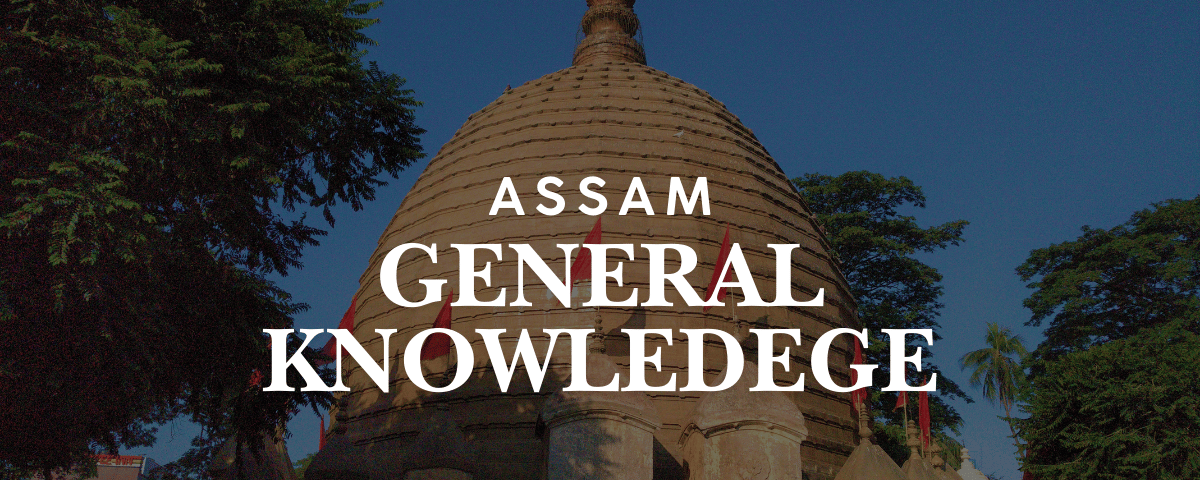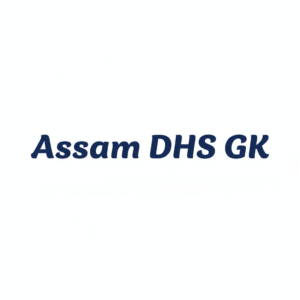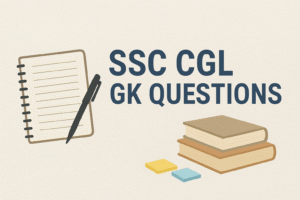Assam History MCQ
This Assam History MCQ compilation includes 100 questions to aid preparation for competitive exams like APSC and UPSC. Covering Assam's ancient dynasties, Ahom rule, battles, and cultural heritage, these Assam History MCQs are essential for mastering Assam's historical narrative
Ancient Names and Early History : Assam history MCQ
1. What is the ancient name for the region now known as Assam, as mentioned in Sanskrit literature?
A) Kamakhya
B) Pragjyotisha
C) Ahom
D) Kamarupa
Answer: B) Pragjyotisha
2. Which is the oldest dynasty mentioned in the mythical history of Assam?
A) Danava
B) Pala
C) Varman
D) Chutia
Answer: A) Danava
3. Among the following, which is the oldest known dynasty of Assam?
A) Ahom Dynasty
B) Varman Dynasty
C) Salastambha Dynasty
D) Pala Dynasty
Answer: B) Varman Dynasty
4. In the historical timeline of Assam, the “Kamarupa” kingdom was displaced by which dynasty?
A) Ahom Dynasty
B) Salastambha Dynasty
C) Pala Dynasty
D) Koch Dynasty
Answer: B) Salastambha Dynasty
5. In Assam, the capital of the Salastambha Dynasty was temporarily shifted to which place?
A) Guwahati
B) Haruppeswara/Hadapeshwara (Tezpur)
C) Koliabor
D) Rangpur
Answer: B) Haruppeswara/Hadapeshwara (Tezpur)
6. The Pala dynasty of Assam claimed descent from:
A) Bhaskarvarman
B) Narakasura
C) Pushyavarman
D) Banasura
Answer: B) Narakasura
7. Who was the last Pala king of Kamrupa, an ancient kingdom in what is now Assam?
A) Brahmapala
B) Jayapala
C) Ratnapala
D) Harshapala
Answer: B) Jayapala
Varman Dynasty : Assam history MCQ
8. Who is considered the founder of the Varman dynasty in the early history of Assam?
A) Bhaskarvarman
B) Pushyavarman
C) Harshavarman
D) Balavarman
Answer: B) Pushyavarman
Ahom Dynasty – Founders and Establishment : Assam history MCQ
9. The Ahom dynasty in Assam was established by which leader?
A) Sukhampha
B) Sukaphaa
C) Rudra Singha
D) Pratap Singha
Answer: B) Sukaphaa
10. Who was the founder of the Ahom dynasty in Assam?
A) Rudra Singha
B) Sukaphaa
C) Gadadhar Singha
D) Pratap Singha
Answer: B) Sukaphaa
11. In which year did the Ahoms enter Assam and establish their capital at Charaideo?
A) 1228 A.D.
B) 1253 A.D.
C) 1238 A.D.
D) 1328 A.D.
Answer: A) 1228 A.D.
12. “Charaideo” is renowned as the sacred capital of which dynasty of Assam?
A) Kachari
B) Ahom
C) Koch
D) Pala
Answer: B) Ahom
13. The capital of the last Ahom king before British annexation of Assam was:
A) Charaideo
B) Garhgaon
C) Jorhat
D) Rangpur
Answer: C) Jorhat
Ahom Dynasty – Kings and Administration : Assam history MCQ
14. Who was the first Ahom king to formally accept Hinduism in the history of Assam?
A) Gadadhar Singha
B) Jayadhwaj Singha
C) Sudangpha (Bamuni Konwar)
D) Pratap Singha
Answer: B) Jayadhwaj Singha
15. Who was the first Ahom king in Assam to perform coronation with Hindu rituals (Singari Ghar Utha)?
A) Sudangpha (Bamuni Konwar)
B) Suteupha
C) Suhungmung
D) Sukapha
Answer: A) Sudangpha (Bamuni Konwar)
16. Who was the first Ahom king to formally adopt Hindu titles such as “Maharaja” in Assam?
A) Suhungmung
B) Sudangpha (Bamuni Konwar)
C) Suhungpha
D) Sukapha
Answer: B) Sudangpha (Bamuni Konwar)
17. Who was known as “Burha Raja” or the “Old King” among the Ahoms in Assam?
A) Rudra Singha
B) Pratap Singha
C) Gadadhar Singha
D) Jayadhwaj Singha
Answer: B) Pratap Singha
18. Who was known as “Burha Raja” because he ascended the throne at an old age in Assam?
A) Rudra Singha
B) Pratap Singha
C) Gadadhar Singha
D) Siva Singha
Answer: B) Pratap Singha
19. During the time of which Ahom ruler was Assamese declared as the official language of the kingdom of Assam?
A) Pratap Singha
B) Siva Singha
C) Surampha
D) Udayaditya Singha
Answer: A) Pratap Singha
20. Who introduced the Paik (Khel) system in the Ahom Kingdom of Assam?
A) Gadadhar Singha
B) Pratap Singha
C) Rudra Singha
D) Siva Singha
Answer: B) Pratap Singha
21. The Paik system, an important labor and military organization in Assam, was systematically implemented by:
A) Lachit Borphukan
B) Momai Tamuli Barbarua
C) Gadadhar Singha
D) Atan Burhagohain
Answer: B) Momai Tamuli Barbarua
22. The Ahom practice of organization of society and army based on clans and groups in historical Assam is called:
A) Paik System
B) Zamindari System
C) Mansabdari
D) Jagirdari
Answer: A) Paik System
23. The Ahom administration in medieval Assam was divided into two main parts managed by:
A) Borgohain and Burhagohain
B) Barphukan and Senapati
C) Patil and Subedar
D) Zamindar and Diwan
Answer: A) Borgohain and Burhagohain
24. The first ever census in Assam was done during the reign of which Ahom king?
A) Pratap Singha
B) Suhungmung
C) Gadadhar Singha
D) Suteupha
Answer: B) Suhungmung
25. The mother of Ahom King Sudangpha was rescued and sheltered by whom in Assam?
A) A Moran chief
B) A Brahmana
C) A Deodhai priest
D) A Koch princess
Answer: B) A Brahmana
26. Which river was fixed as a boundary between the Ahoms and Mungkang by Sudangpha in a treaty in historical Assam?
A) Dhansiri
B) Patkai
C) Subansiri
D) Kopili
Answer: B) Patkai
27. Who first shifted the Ahom capital to Garhgaon in the kingdom of Assam?
A) Suklengmung
B) Pratap Singha
C) Rudra Singha
D) Siva Singha
Answer: A) Suklengmung
28. Who shifted the capital of the Ahom kingdom from Garhgaon to Rangpur in Assam?
A) Siva Singha
B) Rudra Singha
C) Pramatta Singha
D) Rajeshwar Singha
Answer: B) Rudra Singha
29. Who shifted the Ahom capital to Rangpur in Assam?
A) Rudra Singha
B) Siva Singha
C) Gadadhar Singha
D) Pramatta Singha
Answer: A) Rudra Singha
30. The royal capital of the Ahom dynasty was shifted to which city by Rudra Singha in Assam?
A) Garhgaon
B) Rangpur
C) Charaideo
D) Jorhat
Answer: B) Rangpur
31. Who first declared Saktism as the state religion in the Ahom kingdom of Assam?
A) Pramatta Singha
B) Gadadhar Singha
C) Siva Singha
D) Rudra Singha
Answer: C) Siva Singha
32. The “Nag-Shankar” temple was rebuilt by which Ahom king in Assam?
A) Sujangpha
B) Sudangpha (Bamuni Konwar)
C) Sukapha
D) Suhenpha
Answer: A) Sujangpha
Battles and Treaties : Assam history MCQ
33. The Battle of Saraighat, a significant event in the military history of Assam, was fought in:
A) 1640
B) 1671
C) 1682
D) 1826
Answer: B) 1671
34. The Battle of Saraighat took place near which important river flowing through Assam?
A) Teesta
B) Brahmaputra
C) Manas
D) Subansiri
Answer: B) Brahmaputra
35. Who among the following invaded Guwahati during the Battle of Saraighat in historical Assam?
A) Mir Jumla
B) Ram Singh I
C) Turbak Khan
D) Bhagdatta
Answer: B) Ram Singh I
36. Lachit Borphukan is famous in the history of Assam for his role as:
A) Ahom King
B) Chief Minister
C) General in the Battle of Saraighat
D) Religious leader
Answer: C) General in the Battle of Saraighat
37. Who was the Ahom general known for the famous “Momai Kata Garh” rampart in Assam?
A) Lachit Borphukan
B) Atan Burhagohain
C) Momai Tamuli Barbarua
D) Dihingia Alun Barbaruah
Answer: A) Lachit Borphukan
38. The “Battle of Itakhuli” was fought against which power in Assam?
A) Mughals
B) British
C) Burmese
D) Koch dynasty
Answer: A) Mughals
39. The Battle of Itakhuli marked the last battle between which two powers in Assam?
A) Ahoms and British
B) Ahoms and Burmese
C) Ahoms and Mughals
D) Ahoms and Koch
Answer: C) Ahoms and Mughals
40. The treaty that ended the first phase of the Ahom-Mughal conflicts in Assam was:
A) Treaty of Yandaboo
B) Treaty of Ghilazharighat
C) Treaty of Majuli
D) Treaty of Asurar Ali
Answer: D) Treaty of Asurar Ali
41. The Treaty of Asurar Ali was signed in which year during the history of Assam?
A) 1620
B) 1639
C) 1650
D) 1671
Answer: B) 1639
42. The Treaty of Ghilazharighat was signed in which year in the history of Assam?
A) 1663
B) 1532
C) 1615
D) 1682
Answer: A) 1663
43. The Treaty of Yandaboo (which ended Burmese rule and marked the beginning of British rule in Assam) was signed in:
A) 1824
B) 1826
C) 1819
D) 1832
Answer: B) 1826
44. The British formally annexed Assam under which treaty?
A) Treaty of Sugauli
B) Treaty of Yandaboo
C) Treaty of Surji-Anjangaon
D) Treaty of Allahabad
Answer: B) Treaty of Yandaboo
45. The British formally annexed Assam through which treaty?
A) Treaty of Gandamak
B) Treaty of Yandaboo
C) Treaty of Sugauli
D) Treaty of Titalia
Answer: B) Treaty of Yandaboo
46. What historic event marks the end of Ahom rule in Assam?
A) Battle of Saraighat
B) Treaty of Ghilazharighat
C) Treaty of Yandaboo
D) Anglo-Burmese War
Answer: C) Treaty of Yandaboo
Ahom Dynasty-Monuments and Architecture in Assam : Assam history MCQ
47. Which of the following monuments is known as Asia’s first amphitheatre and is located in Assam?
A) Kareng Ghar
B) Talatal Ghar
C) Rang Ghar
D) Joysagar
Answer: C) Rang Ghar
48. “Rang Ghar” is located in which district of Assam?
A) Jorhat
B) Sivasagar
C) Dibrugarh
D) Tezpur
Answer: B) Sivasagar
49. Who constructed the Talatal Ghar in historical Assam?
A) Rudra Singha
B) Rajeshwar Singha
C) Siva Singha
D) Pramatta Singha
Answer: B) Rajeshwar Singha
50. The famous Maidams (burial mounds) are associated with which dynasty of Assam?
A) Kachari
B) Ahom
C) Koch
D) Salastambha
Answer: B) Ahom
51. Which Ahom king in Assam is credited with the construction of the Umananda temple?
A) Gadadhar Singha
B) Rudra Singha
C) Siva Singha
D) Pramatta Singha
Answer: A) Gadadhar Singha
52. The Jayasagar Tank at Sivasagar in Assam was constructed by:
A) Pramatta Singha
B) Rudra Singha
C) Siva Singha
D) Rajeshwar Singha
Answer: B) Rudra Singha
53. The Jayasagar Tank is located in which city of Assam?
A) Tezpur
B) Guwahati
C) Sivasagar
D) Nagaon
Answer: C) Sivasagar
54. The largest man-made lake in Assam is:
A) Joysagar
B) Sibsagar
C) Dighalipukhuri
D) Gaurisagar
Answer: A) Joysagar
55. Who built the Namdang Stone Bridge in Assam?
A) Rudra Singha
B) Gadadhar Singha
C) Pramatta Singha
D) Siva Singha
Answer: A) Rudra Singha
56. Which king constructed the Namdang Stone Bridge in Assam?
A) Pramatta Singha
B) Rudra Singha
C) Gadadhar Singha
D) Siva Singha
Answer: B) Rudra Singha
57. Who built the historic tank “Gaurisagar” in Assam?
A) Rudra Singha
B) Siva Singha’s queen Phuleshwari
C) Rajeshwar Singha
D) Ahom king Pramatta Singha
Answer: B) Siva Singha’s queen Phuleshwari
58. On the bank of which tank was the Shiva temple “Sivadol” at Sivasagar built in Assam?
A) Sibsagar tank
B) Joysagar tank
C) Rupahi tank
D) Rudrasagar tank
Answer: A) Sibsagar tank
59. The “Dighali Pukhuri” in Guwahati, Assam, is associated with which legendary king?
A) Banasura
B) Bhagadatta
C) Pratap Singha
D) Gadadhar Singha
Answer: B) Bhagadatta
60. The “Dighali Pukhuri” in Guwahati, Assam, is believed to be excavated by whom?
A) Bhaskarvarman
B) Bhagadatta
C) Narakasura
D) Rudra Singha
Answer: B) Bhagadatta
Kamakhya Temple and Other Important Dynasties in Assam : Assam history MCQ
61. Kamakhya Temple in Assam was built by which king?
A) Koch King Naranarayan
B) Ahom King Rudra Singha
C) Pala King Dharmapala
D) Salastambha King Harshadeva
Answer: A) Koch King Naranarayan
62. The Kamakhya Temple is situated on which hill in Assam?
A) Nilachal Hill
B) Shillong Hill
C) Manas Hill
D) Karbi Hill
Answer: A) Nilachal Hill
63. Who was the founder of the Pala dynasty of Kamrupa, the ancient kingdom in present-day Assam?
A) Ratnapala
B) Brahmapala
C) Purandarapala
D) Dharmapala
Answer: B) Brahmapala
64. In Assam’s early history, Sati Sadhani belonged to which dynasty?
A) Chutia
B) Koch
C) Ahom
D) Pala
Answer: A) Chutia
65. The Kamata Kingdom was located in which present-day area of Assam and nearby regions?
A) Kamrup
B) Goalpara
C) Western Assam and North Bengal
D) Barak valley
Answer: C) Western Assam and North Bengal
Rebellions and Uprisings in Assam:Assam history MCQ
66. The Moamoriya Rebellion began during the reign of which king of Assam?
A) Jayadhwaj Singha
B) Laxmi Singha
C) Gadadhar Singha
D) Purandar Singha
Answer: B) Laxmi Singha
67. The Moamoriya Rebellion started during the reign of:
A) Kamaleshwar Singha
B) Laxmi Singha
C) Gadadhar Singha
D) Pramatta Singha
Answer: B) Laxmi Singha
68. The Moamoriya Rebellion was ultimately quelled during the reign of which Ahom king in Assam?
A) Kamaleshwar Singha
B) Chandrakanta Singha
C) Siva Singha
D) Laxmi Singha
Answer: B) Chandrakanta Singha
69. The first peasant uprising in Assam, known as Phulaguri Dhawa, took place in which year?
A) 1857
B) 1861
C) 1894
D) 1901
Answer: B) 1861
70. The famous “Phulaguri Dhawa” uprising was held in:
A) 1857
B) 1861
C) 1894
D) 1905
Answer: B) 1861
71. Phulaguri Dhawa, the first significant peasant uprising in colonial Assam, was against which British policy?
A) Land revenue increase
B) Poppy cultivation ban and tamul-paan tax
C) Tea export fees
D) Opium import
Answer: B) Poppy cultivation ban and tamul-paan tax
72. The Phulaguri Dhawa uprising was primarily caused by:
A) Increase in tax on salt
B) Ban on poppy cultivation
C) Imposition of British land laws
D) British annexation of Cachar
Answer: B) Ban on poppy cultivation
73. The “Rangia Uprising” in colonial Assam occurred in which year?
A) 1861
B) 1893
C) 1894
D) 1905
Answer: B) 1893
74. The 1857 rebellion’s prominent leader from Assam was:
A) Piyoli Barua
B) Maniram Dewan
C) Tarun Ram Phukan
D) Kanaklata Barua
Answer: B) Maniram Dewan
Cultural and Literary Contributions of Assam: Assam history MCQ
75. The Ahom chronicles were known as:
A) Sattras
B) Buranjis
C) Charitas
D) Sahityas
Answer: B) Buranjis
76. The “Buranjis” are:
A) Religious texts of Ahoms
B) Chronicles or historical records of Assam
C) Folk songs of Assam
D) Temples built by Ahoms
Answer: B) Chronicles or historical records
77. The author of “Hastividyarnava,” the important book on elephants in the history of Assam, was:
A) Rudra Singha
B) Sukumar Borkaith
C) Kaviraj Chakraborty
D) Hiteshwar Barbaruah
Answer: B) Sukumar Borkaith
78. Srimanta Sankardev is known as the founder of which religious movement in Assam?
A) Shaktism
B) Buddhism
C) Vaishnavism
D) Jainism
Answer: C) Vaishnavism
79. Who popularized the Satriya dance and Neo-Vaishnavism in Assam?
A) Sri Sankardev
B) Rudra Singha
C) Siva Singha
D) Gadadhar Singha
Answer: A) Sri Sankardev
80. The “Rikkhvan Ceremony” in the tradition of Assam symbolized:
A) Rebirth and victory
B) Harvest festival
C) Anointment of a queen
D) Building a temple
Answer: A) Rebirth and victory
81. “Rikkhvan Ceremony” was performed after the victory over which kingdom in Assam?
A) Chutia
B) Kachari
C) Koch
D) Mughal
Answer: A) Chutia
82. “Singari Ghar Utha” refers to:
A) Coronation ceremony of Ahom kings in Assam
B) Construction of marriage halls
C) Ritual for new year
D) Buddhist festival
Answer: A) Coronation ceremony of Ahom kings
83. The first conference of Assam Sahitya Sabha was held at which place in Assam?
A) Nagaon
B) Jorhat
C) Tezpur
D) Sivasagar
Answer: D) Sivasagar
84. The first Assamese film, “Joymoti,” was released in which year in Assam?
A) 1927
B) 1932
C) 1935
D) 1940
Answer: C) 1935
85. The first Assamese film was:
A) Joymoti
B) Piyoli Phukan
C) Indramalati
D) Monomoti
Answer: A) Joymoti
Modern History and Awards Related to Assam:Assam history MCQ
86. Who was the first Assamese recipient of the Bharat Ratna award?
A) S. N. Bordoloi
B) Bhupen Hazarika
C) Gopinath Bordoloi
D) Mamoni Raisom Goswami
Answer: C) Gopinath Bordoloi
87. The title “Bharat Ratna” was awarded posthumously to which great Assamese personality in 1999?
A) Lakshminath Bezbaruah
B) Bhupen Hazarika
C) Gopinath Bordoloi
D) Bishnu Rabha
Answer: C) Gopinath Bordoloi
88. The title “Bharat Ratna” was awarded to Bhupen Hazarika in which year?
A) 1995
B) 1999
C) 2000
D) 2019
Answer: D) 2019
89. Which Assamese leader is known as the ‘Father of Assamese Nationalism'?
A) Gopinath Bordoloi
B) Manik Chandra Baruah
C) Lakshminath Bezbaruah
D) Ambikagiri Raychoudhury
Answer: A) Gopinath Bordoloi
90. Who founded the Assam Association, one of the earliest political organizations in Assam, in 1903?
A) Nabin Chandra Bordoloi
B) Manik Chandra Baruah
C) Kuladhar Chaliha
D) Prabhat Chandra Baruah
Answer: B) Manik Chandra Baruah
91. Who founded the “Jorhat Sarbajanik Sabha” in Assam in 1884?
A) Nabin Chandra Bordoloi
B) Jagannath Baruah
C) Manik Chandra Baruah
D) Prabhat Chandra Baruah
Answer: B) Jagannath Baruah
92. The “Jorhat Sarbajanik Sabha” was founded in which year?
A) 1882
B) 1884
C) 1888
D) 1890
Answer: B) 1884
93. Who was the First Chief Minister of independent Assam?
A) Gopinath Bordoloi
B) Bimala Prasad Chaliha
C) Tarun Gogoi
D) Anwara Taimur
Answer: A) Gopinath Bordoloi
94. In which year was Assamese declared the official language of Assam?
A) 1947
B) 1960
C) 1961
D) 1971
Answer: C) 1961
95. In which year did the capital of Assam shift to Dispur?
A) 1960
B) 1972
C) 1975
D) 1980
Answer: B) 1972
96. Which festival marks the Assamese New Year in Assam?
A) Bihu
B) Baishagu
C) Magh Bihu
D) Durga Puja
Answer: A) Bihu
97. One of the animals widely used in wars in ancient Assam was:
A) Bull
B) Camel
C) Horse
D) Elephant
Answer: D) Elephant
98. The Pala dynasty of Assam claimed descent from which legendary figure?
A) Samudra-varman
B) Bhaskar-varman
C) Vanamala-varman
D) Narakasura
Answer: D) Narakasura
99. During the reign of which Assam king was the temple of Navagraha built?
A) Indrapal
B) Nitipal
C) Birpal
D) Jashpal
Answer: A) Indrapal
100. Who built the stone bridge over the river Namdang in Assam?
A) Rudra Singha
B) Gadadhar Singha
C) Pramatta Singha
D) Siva Singha
Answer: A) Rudra Singha
You’ve completed Part 1 of the Assam history MCQs, mastering key facts about modern, ancient and mythological Assam. This solid base prepares you for the next stages of Assam’s journey through its glorious Ahom era and medieval transformations. Keep practicing to refine your understanding and maintain your momentum as you advance to Part 2. Stay curious and confident.
Other Parts of Assam History MCQs
100 Assam History MCQs for Competitive Exams Part 2
100 Assam History MCQs for Competitive Exams Part 3
100 Assam History MCQs for Competitive Exams Part 4
Popular MCQs
300 Spartans Story: The Battle of Thermopylae and the Legacy of Ancient Warfare
The Poona Pact 1932 | Historical Significance, Key Provisions, and Impact on Dalit Rights
The Early History of Assam – Exploring the Roots of an Ancient Land





